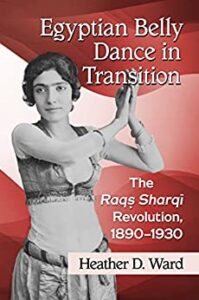Here’s another blog in my review series, this time reviewing a book by Heather Ward on the origins of belly dance: Egyptian Belly Dance in Transition: The Raqs Sharqi Revolution, 1890-1930. I recommend it to any belly dance enthusiasts who enjoy learning about the roots of belly dance. This post will give you an overview of how belly dance came to be ‘belly dance’. I hope it will whet your appetite for reading the full book!

Busting Orientalist Stereotypes of Belly Dance
Heather’s book busts widespread orientalist stereotypes of belly dance. In Heather’s words, people believe that:
… raqs sharqi [belly dance] was created by Egyptians in response to Western influences and desires. The argument goes that savvy Egyptian entertainment hall owners, catering to Western audiences as well as to upper-class Egyptian audiences with Western tastes, created a dance and associated costuming style that embodied Westerners’ Orientalist fantasies of Middle Eastern dance. The name that is most commonly invoked with this argument is Badi’ah Masabni, the Syrian entertainer and entrepreneur who owned several entertainment halls in Cairo and Alexandria from the 1920s through the 1940s. Indeed, many aficionados of raqs sharqi believe that Badi’ah single-handedly invented the dance.
p. 49, Egyptian Belly Dance in Transition
Dance students and performers have formed this view over time through group consensus. An irrational, backwards ‘East’ presumably yields to a dominating, powerful, rational west. This is the ‘Orientalist’ stereotype. Heather users her academic training to question and refute this narrative. She bases her analysis on Arabic language primary sources. She supplements this with foreign language sources viewed with a critical eye. She shows how Egyptians created raqs sharqi for Egyptians. Egyptians adopted foreign ideas and technology for their own purposes. They created an authentically Egyptian cultural expression from indigenous and foreign influences.
Overview of the Origins of Belly Dance
So if Egyptians created belly dance for Egyptians, how did it come about anyway? Professional female entertainers called the ‘awalim and the ghawazi existed pre-belly dance. In the 1700s and 1800s, people hired them to perform for family events. Such events included celebrations of birth, marriage, and public festivals. In 1830 the Ottoman governor of Egypt, Muhammad Ali, banned public performance by female entertainers. The propriety of the female entertainers concerned the public. They were often associated with prostitution and other vices. By the early 1900s, dancers migrated to performing in urban entertainment halls. They did this to evade restrictions on public performance such as traditional celebrations.
These entertainment halls were a melting pot. Dancers and performers from all over the world mingled and met. Dancers came from all over Egypt, North Africa, the Mediterranean, Middle East, and Europe. In this space, ‘awalim/ghawazi dance absorbed influences from a variety of dance styles and aesthetics. It became the raqs sharqi we know today. Heather identifies two features which differentiate raqs sharqi as a concert dance from dances of the awalim and the ghawazi. These are: “(1) Performance for the sake of performance, and (2) Performance for a primarily non-participating audience” (p. 58). They were in place as early as the 1890s in dance and entertainment halls. Following the era of the urban music hall of the 1920s, the new medium of television disseminated raqs sharqi to the wider Egyptian public. The ‘golden era’ films of the 1930s to the 1960s cemented raqs sharqi as a part of the Egyptian cultural heritage.
If this brief summary of belly dance history is of interest to you, I urge you to read Heather’s book, which covers the full story in much more detail. A word of warning – the language can be somewhat formal and academic at times, but it is worth persevering. Heather’s book is a fascinating historical overview of belly dance as authentically Egyptian. It busts the stereotypical Orientalist view that it was created to ‘please Westerners’. I hope you read and enjoy it!
Recommended Reading
Ward, Heather D. 2018. Egyptian Belly Dance in Transition. Jefferson, NC, USA: McFarland.
